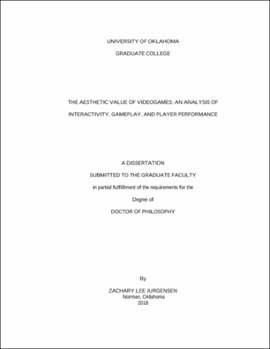| dc.description.abstract | In this dissertation, I set out to examine the artistic and aesthetic features of videogames as games. Ultimately, I argue that a complete understanding of the aesthetics of videogames requires a more robust account of the role of the player and the aesthetic impact of the choices she makes than has been previously given. While the idea that videogames are a strongly interactive media is acknowledged in the literature, less attention is given to how the unique relationship between game and gamer affects both the overall aesthetic experience of playing videogames and the position these games hold in the artworld.
I first argue that the prevalent attempts at categorizing videogames as art fall prey to a similar pitfall, which ultimately contributes to a common mishandling of the aesthetic value videogames can offer. After highlighting the problems that the leading theories of art have in defining videogames as art, I turn attention to interrelated concepts of interactivity, gameplay, and player performance.
I develop an original account of interactivity as it relates to videogames. My account is meant to capture the uniqueness videogames offer as works of art and also the importance interactivity plays in understanding the aesthetic experience of playing videogames. Working from my proposed account of interactivity, I then look to concepts of gameplay and player performance and how they relate to the overall aesthetic experience of playing videogames. I argue that gameplay mechanics affect the overall aesthetic value of videogames by both delimiting and creating opportunities for how the player engages with the game. In this way, gameplay mechanics need to be taken into account when evaluating the overall functionality of a videogame as a game, and subsequently, need to be considered when assessing the aesthetic quality of a videogame. Moreover, how a player chooses to utilize and navigate gameplay mechanics with respect to the choices she makes when interacting with the game ultimately affect the aesthetic experience she has while playing. Hence, I argue that player performance can have a significant impact the aesthetic quality of videogame play.
In doing so, I highlight how the atypical relationship among artist, audience, and artwork in videogames plays a pivotal role in shaping the aesthetic experience of gameplay. Finally, I offer a defense against the argument that even if videogames are art, they are artistically and aesthetically worthless. In doing so, I develop a novel account of kitsch gameplay to better understand and evaluate videogames as artworks. | en_US |
